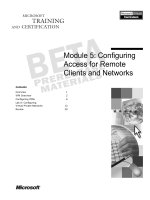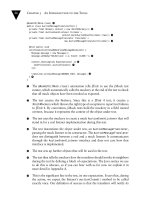Tài liệu Design and Implementation Guidelines for Web Clients- P2 pdf
Bạn đang xem bản rút gọn của tài liệu. Xem và tải ngay bản đầy đủ của tài liệu tại đây (495.71 KB, 253 trang )
and Asynchronous
Programming in Web Applications
In This Chapter
This chapter describes how to use two closely related mechanisms to enable
you to
design scaleable and responsive presentation layers for ASP.NET Web
applications.
The two mechanisms are:
● Multithreading
● Asynchronous programming
Performance and responsiveness are important factors in the success of your
application.
Users quickly tire of using even the most functional application if it is
unresponsive
or regularly appears to freeze when the user initiates an action. Even
though it may be a back-end process or external service causing these
problems,
it is the user interface where the problems become evident.
Multithreading and asynchronous programming techniques enable you to
overcome
these difficulties. The Microsoft .NET Framework class library makes these
mechanisms
easily accessible, but they are still inherently complex, and you must design
your application with a full understanding of the benefits and consequences
that
these mechanisms bring. In particular, you must keep in mind the following
points
as you decide whether to use one of these threading techniques in your
application:
● More threads does not necessarily mean a faster application. In fact, the
use of
too many threads has an adverse effect on the performance of your
application.
For more information, see “Using the Thread Pool” later in this chapter.
● Each time you create a thread, the system consumes memory to hold
context
information for the thread. Therefore, the number of threads that you can
create
is limited by the amount of memory available.
116 Design and Implementation Guidelines for Web Clients
● Implementation of threading techniques without sufficient design is likely
to lead
to overly complex code that is difficult to scale and extend.
● You must be aware of what could happen when you destroy threads in
your
application, and make sure you handle these possible outcomes accordingly.
● Threading-related bugs are generally intermittent and difficult to isolate,
debug,
and resolve.
The following sections describe multithreading and asynchronous
programming
from the perspective of presentation layer design in ASP.NET Web
applications. For
information about how to use these mechanisms in Windows Forms-based
applications,
see “Multithreading and Asynchronous Programming in Windows Forms-
Based Applications” in the appendix of this guide.
Multithreading
There are many situations where using additional threads to execute tasks
allows
you to provide your users with better performance and higher responsiveness
in
your application, including:
● When there is background processing to perform, such as waiting for
authorization
from a credit-card company in an online retailing Web application
● When you have a one-way operation, such as invoking a Web service to
pass data
entered by the user to a back-end system
● When you have discrete work units that can be processed independently,
such as
calling several SQL stored procedures simultaneously to gather information
that
you require to build a Web response page
Used appropriately, additional threads allow you to avoid your user interface
from
becoming unresponsive during long-running and computationally intensive
tasks.
Depending on the nature of your application, the use of additional threads
can
enable the user to continue with other tasks while an existing operation
continues in
the background. For example, an online retailing application can display a
“Credit
Card Authorization In Progress” page in the client’s Web browser while a
background
thread at the Web server performs the authorization task. When the
authorization
task is complete, the background thread can return an appropriate “Success”
or “Failure” page to the client. For an example of how to implement this
scenario,
see “How to: Execute a Long-Running Task in a Web Application” in
Appendix B
of this guide.
Note: Do not display visual indications of how long it will take for a
long-running task to
complete. Inaccurate time estimations confuse and annoy users. If
you do not know the scope
of an operation, distract the user by displaying some other kind of
activity indictor, such as an
animated GIF image, promotional advertisement, or similar page.
Chapter 6: Multithreading and Asynchronous Programming in Web
Applications 117
Unfortunately, there is a run-time overhead associated with creating and
destroying
threads. In a large application that creates new threads frequently, this
overhead can
affect the overall application performance. Additionally, having too many
threads
running at the same time can drastically decrease the performance of a
whole
system as Windows tries to give each thread an opportunity to execute.
Using the Thread Pool
A common solution to the cost of excessive thread creation is to create a
reusable
pool of threads. When an application requires a new thread, instead of
creating one,
the application takes one from the thread pool. As the thread completes its
task,
instead of terminating, the thread returns to the pool until the next time the
application
requires another thread.
Thread pools are a common requirement in the development of scaleable,
highperformance
applications. Because optimized thread pools are notoriously difficult
to implement correctly, the .NET Framework provides a standard
implementation in
the System.Threading.ThreadPool class. The thread pool is created the
first time
you create an instance of the System.Threading.ThreadPool class.
The runtime creates a single thread pool for each run-time process (multiple
application
domains can run in the same runtime process.) By default, this pool contains
a
maximum of 25 worker threads and 25 asynchronous I/O threads per
processor
(these sizes are set by the application hosting the common language
runtime).
Because the maximum number of threads in the pool is constrained, all the
threads
may be busy at some point. To overcome this problem, the thread pool
provides a
queue for tasks awaiting execution. As a thread finishes a task and returns to
the
pool, the pool takes the next work item from the queue and assigns it to the
thread
for execution.
Benefits of Using the Thread Pool
The runtime-managed thread pool is the easiest and most reliable approach
to
implement multithreaded applications. The thread pool offers the following
benefits:
● You do not have to worry about thread creation, scheduling, management,
and
termination.
● Because the thread pool size is constrained by the runtime, the chance of
too
many threads being created and causing performance problems is avoided.
● The thread pool code is well tested and is less likely to contain bugs than a
new
custom thread pool implementation.
● You have to write less code, because the thread start and stop routines are
managed internally by the .NET Framework.
118 Design and Implementation Guidelines for Web Clients
The following procedure describes how to use the thread pool to perform a
background
task in a separate thread.
_ To use the thread pool to perform a background task
1. Write a method that has the same signature as the WaitCallback
delegate.
This delegate is located in the System.Threading namespace, and is defined
as follows.
[Serializable]
public delegate void WaitCallback(object state);
2. Create a WaitCallback delegate instance, specifying your method as the
callback.
3. Pass the delegate instance into the ThreadPool.QueueUserWorkItem
method to
add your task to the thread pool queue. The thread pool allocates a thread for
your method from the thread pool and calls your method on that thread.
In the following code, the AuthorizePayment method is executed in a thread
allocated from the thread pool.
using System.Threading;
public class CreditCardAuthorizationManager
{
private void AuthorizePayment(object o)
{
// Do work here ...
}
public void BeginAuthorizePayment(int amount)
{
ThreadPool.QueueUserWorkItem(new
WaitCallback(AuthorizePayment));
}
}
For a more detailed discussion of the thread pool, see “Programming the
Thread
Pool in the .NET Framework” on MSDN (
/default.asp?url=/library/en-us/dndotnet/html/progthrepool.asp).
Limitations of Using the Thread Pool
Unfortunately, the thread pool suffers limitations resulting from its shared
nature
that may prevent its use in some situations. In particular, these limitations
are:
● The .NET Framework also uses the thread pool for asynchronous
processing,
placing additional demands on the limited number of threads available.
● Even though application domains provide robust application isolation
boundaries,
code in one application domain can affect code in other application
domains in the same process if it consumes all the threads in the thread pool.
Chapter 6: Multithreading and Asynchronous Programming in Web
Applications 119
● When you submit a work item to the thread pool, you do not know when a
thread becomes available to process it. If the application makes particularly
heavy use of the thread pool, it may be some time before the work item
executes.
● You have no control over the state and priority of a thread pool thread.
● The thread pool is unsuitable for processing simultaneous sequential
operations,
such as two different execution pipelines where each pipeline must proceed
from
step to step in a deterministic fashion.
● The thread pool is unsuitable when you need a stable identity associated
with the
thread, for example if you want to use a dedicated thread that you can
discover
by name, suspend, or abort.
In situations where use of the thread pool is inappropriate, you can create
new
threads manually. Manual thread creation is significantly more complex than
using
the thread pool, and it requires you to have a deeper understanding of the
thread
lifecycle and thread management. A discussion of manual thread creation
and
management is beyond the scope of this guide. For more information, see
“Threading” in the “.NET Framework Developer’s Guide” on MSDN
(http://
msdn.microsoft.com/library/default.asp?url=/library/en-us/cpguide/html
/cpconthreading.asp).
Synchronizing Threads
If you use multiple threads in your applications, you must address the issue
of
thread synchronization. Consider the situation where you have one thread
iterating
over the contents of a hash table and another thread that tries to add or delete
hash
table items. The thread that is performing the iteration is having the hash
table
changed without its knowledge; this causes the iteration to fail.
The ideal solution to this problem is to avoid shared data. In some situations,
you
can structure your application so that threads do not share data with other
threads.
This is generally possible only when you use threads to execute simple one-
way
tasks that do not have to interact or share results with the main application.
The
thread pool described earlier in this chapter is particularly suited to this
model
of execution.
Synchronizing Threads by Using a Monitor
It is not always feasible to isolate all the data a thread requires. To get thread
synchronization,
you can use a Monitor object to serialize access to shared resources by
multiple threads. In the hash table example cited earlier, the iterating thread
would
obtain a lock on the Hashtable object using the Monitor.Enter method,
signaling to
other threads that it requires exclusive access to the Hashtable. Any other
thread
that tries to obtain a lock on the Hashtable waits until the first thread
releases the
lock using the Monitor.Exit method.
120 Design and Implementation Guidelines for Web Clients
The use of Monitor objects is common, and both Visual C# and Visual
Basic .NET
include language level support for obtaining and releasing locks:
● In C#, the lock statement provides the mechanism through which you
obtain the
lock on an object as shown in the following example.
lock (myHashtable)
{
// Exclusive access to myHashtable here...
}
● In Visual Basic .NET, the SyncLock and End SyncLock statements
provide the
mechanism through which you obtain the lock on an object as shown in the
following example.
SyncLock (myHashtable)
' Exclusive access to myHashtable here...
End SyncLock
When entering the lock (or SyncLock) block, the static (Shared in Visual
Basic .NET)
System.Monitor.Enter method is called on the specified expression. This
method
blocks until the thread of execution has an exclusive lock on the object
returned by
the expression.
The lock (or SyncLock) block is implicitly contained by a try statement
whose
finally block calls the static (or Shared) System.Monitor.Exit method on
the expression.
This ensures the lock is freed even when an exception is thrown. As a result,
it
is invalid to branch into a lock (or SyncLock) block from outside of the
block.
For more information about the Monitor class, see “Monitor Class” in the
“.NET
Framework Class Library” on MSDN (
/default.asp?url=/library/en-
us/cpref/html/frlrfsystemthreadingmonitorclasstopic.asp).
Using Alternative Thread Synchronization Mechanisms
The .NET Framework provides several other mechanisms that enable you to
synchronize
the execution of threads. These mechanisms are all exposed through classes
in the System.Threading namespace. The mechanisms relevant to the
presentation
layer are listed in Table 6.1.
Chapter 6: Multithreading and Asynchronous Programming in Web
Applications 121
Table 6.1: Thread Synchronization Mechanisms
Mechanism Description Links for More Information
ReaderWriterLock Defines a lock that implements
single-writer/multiple-reader /default.asp?url=/library/en-us
semantics; this allows many /cpref/html/frlrfsystemthreading
readers, but only a single writer, readerwriterlockclasstopic.asp
to access a synchronized object.
Used where classes do much
more reading than writing.
AutoResetEvent Notifies one or more waiting
threads that an event has /default.asp?url=/library/en-us
occurred. /cpref/html/frlrfsystemthreading
autoreseteventclasstopic.asp
When the AutoResetEvent
transitions from a non-signaled to
signaled state, it allows only a
single waiting thread to resume
execution before reverting to the
non-signaled state.
ManualResetEvent Notifies one or more waiting
threads that an event has /default.asp?url=/library/en-us
occurred. /cpref/html/frlrfsystemthreading
manualreseteventclasstopic.asp
When the ManualResetEvent
transitions from a non-signaled to
signaled state, all waiting threads
are allowed to resume execution.
Mutex A Mutex can have a name; this
allows threads in other processes /default.asp?url=/library/en-us
to synchronize on the Mutex; only /cpref/html/frlrfsystemthreading
one thread can own the Mutex at mutexclasstopic.asp
any particular time providing a
machine-wide synchronization
mechanism.
Another thread can obtain the
Mutex when the owner releases it.
Principally used to make sure only
a single application instance can
be run at the same time.
122 Design and Implementation Guidelines for Web Clients
With such a rich selection of synchronization mechanisms available to you,
you
must plan your thread synchronization design carefully and consider the
following
points:
● It is a good idea for threads to hold locks for the shortest time possible. If
threads
hold locks for long periods of time, the resulting thread contention can
become a
major bottleneck, negating the benefits of using multiple threads in the first
place.
● Be careful about introducing deadlocks caused by threads waiting for
locks held
by other threads. For example, if one thread holds a lock on object A and
waits
for a lock on object B, while another thread holds a lock on object B, but
waits to
lock object A, both threads end up waiting forever.
● If for some reason an object is never unlocked, all threads waiting for the
lock end
up waiting forever. The lock (C#) and SyncLock (Visual Basic .NET)
statements
make sure that a lock is always released even if an exception occurs. If you
use
Monitor.Enter manually, you must make sure that your code calls
Monitor.Exit.
Using multiple threads can significantly enhance the performance of your
presentation
layer components, but you must make sure you pay close attention to thread
synchronization issues to prevent locking problems.
Troubleshooting
The difficulties in identifying and resolving problems in multi-threaded
applications
occur because the CPU’s scheduling of threads is non-deterministic; you
cannot
reproduce the exact same code execution sequence across multiple test runs.
This
means that a problem may occur one time you run the application, but it may
not
occur another time you run it. To make things worse, the steps you typically
take to
debug an application — such as using breakpoints, stepping through code,
and
logging — change the threading behavior of a multithreaded program and
frequently
mask thread-related problems. To resolve thread-related problems, you
typically
have to set up long-running test cycles that log sufficient debug information
to allow
you to understand the problem when it occurs.
Note: For more in-depth information about debugging, see
“Production Debugging for .NET
Framework Applications” on MSDN
(
/en-us/dnbda/html/DBGrm.asp).
Chapter 6: Multithreading and Asynchronous Programming in Web
Applications 123
Using Asynchronous Operations
Some operations take a long time to complete. These operations generally
fall into
two categories:
● I/O bound operations such as calling SQL Server, calling a Web service,
or calling
a remote object using .NET Framework remoting
● CPU-bound operations such as sorting collections, performing complex
mathematical
calculations, or converting large amounts of data
The use of additional threads to execute long running tasks is a common way
to
maintain responsiveness in your application while the operation executes.
Because
threads are used so frequently to overcome the problem of long running
processes,
the .NET Framework provides a standardized mechanism for the invocation
of
asynchronous operations that saves you from working directly with threads.
Typically, when you invoke a method, your application blocks until the
method
is complete; this is known as synchronous invocation. When you invoke a
method
asynchronously, control returns immediately to your application; your
application
continues to execute while the asynchronous operation executes
independently. Your
application either monitors the asynchronous operation or receives
notification by
way of a callback when the operation is complete; this is when your
application can
obtain and process the results.
The fact that your application does not block while the asynchronous
operation
executes means the application can perform other processing. The approach
you use
to invoke the asynchronous operation (discussed in the next section)
determines
how much scope you have for processing other tasks while waiting for the
operation
to complete.
Using the .NET Framework Asynchronous Execution Pattern
The .NET Framework allows you to execute any method asynchronously
using the
asynchronous execution pattern. This pattern involves the use of a delegate
and
three methods named Invoke, BeginInvoke, and EndInvoke.
The following example declares a delegate named AuthorizeDelegate. The
delegate
specifies the signature for methods that perform credit card authorization.
public delegate int AuthorizeDelegate(string creditcardNumber,
DateTime expiryDate,
double amount);
When you compile this code, the compiler generates Invoke, BeginInvoke,
and
EndInvoke methods for the delegate. Figure 6.1 on the next page shows
how these
methods appear in the IL Disassembler.
124 Design and Implementation Guidelines for Web Clients
Figure 6.1
MSIL signatures for the Invoke, BeginInvoke, and EndInvoke methods in a
delegate
The equivalent C# signatures for these methods are as follows.
// Signature of compiler-generated BeginInvoke method
public IAsyncResult BeginInvoke(string creditcardNumber,
DateTime expiryDate,
double amount,
AsyncCallback callback,
object asyncState);
// Signature of compiler-generated EndInvoke method
public int EndInvoke(IAsyncResult ar);
// Signature of compiler-generated Invoke method
public int Invoke(string creditcardNumber,
DateTime expiryDate,
double amount);
The following sections describe the BeginInvoke, EndInvoke, and Invoke
methods,
and clarify their role in the asynchronous execution pattern. For full details
on how
to use the asynchronous execution pattern, see “Including Asynchronous
Calls” in
the “.NET Framework Developer’s Guide” on MSDN
(
/library/default.asp?url=/library/en-
us/cpguide/html/cpconasynchronousprogramming.asp).
Performing Synchronous Execution with the Invoke Method
The Invoke method synchronously executes the method referenced by the
delegate
instance. If you call a method by using Invoke, your code blocks until the
method
returns.
Using Invoke is similar to calling the referenced method directly, but there
is one
significant difference. The delegate simulates synchronous execution by
calling
BeginInvoke and EndInvoke internally. Therefore your method is executed
in the
context of a different thread to the calling code, even though the method
appears to
execute synchronously. For more information, see the description of
BeginInvoke in
the next section.
Chapter 6: Multithreading and Asynchronous Programming in Web
Applications 125
Initiating Asynchronous Operations with the BeginInvoke Method
The BeginInvoke method initiates the asynchronous execution of the
method
referenced by the delegate instance. Control returns to the calling code
immediately,
and the method referenced by the delegate executes independently in the
context of
a thread from the runtime’s thread pool.
The “Multithreading” section earlier in this chapter describes the thread pool
in
detail; however, it is worth highlighting the consequences of using a separate
thread,
and in particular one drawn from the thread pool:
● The runtime manages the thread pool. You have no control over the
scheduling of
the thread, nor can you change the thread’s priority.
● The runtime’s thread pool contains 25 threads per processor. If you invoke
asynchronous operations too liberally, you can easily exhaust the pool
causing
the runtime to queue excess asynchronous operations until a thread becomes
available.
● The asynchronous method runs in the context of a different thread to the
calling
code. This causes problems when asynchronous operations try to update
Windows
Forms components.
The signature of the BeginInvoke method includes the same arguments as
those
specified by the delegate signature. It also includes two additional arguments
to
support asynchronous completion:
● callback argument – Specifies an AsyncCallback delegate instance. If
you specify
a non-null value for this argument, the runtime calls the specified callback
method when the asynchronous method completes. If this argument is a null









